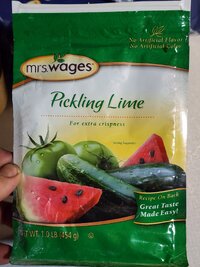What’s your storage plan
Glassing. You place them unwashed in water and add pickling lime. Room temp storage for up to a year.
If you enjoy the forum please consider supporting it by signing up for a NES Membership The benefits pay for the membership many times over.
Be sure to enter the NES/MFS May Giveaway ***Canik METE SFX***
What’s your storage plan
can you give the lime-water ratio? does it change the taste or texture at all? thanks.Glassing. You place them unwashed in water and add pickling lime. Room temp storage for up to a year.


Eat him.One of my pullets ended up being a rooster.
He's not aggressive, but I don't plan on raising chicks.
Pros and cons of keeping a rooster?
I love my rooster. He is not aggressive but he keeps the hens safe and let's me know when he doesn't like something in the yard. I have killed lots of predators because he crowed.One of my pullets ended up being a rooster.
He's not aggressive, but I don't plan on raising chicks.
Pros and cons of keeping a rooster?
I ended up culling a couple I had once they started to crow. We have a no rooster and 6 hen, town ordinance. Normally, I could give a crap about what the town says I can have, but I do not want to draw any attention and you know, chicken math.One of my pullets ended up being a rooster.
He's not aggressive, but I don't plan on raising chicks.
Pros and cons of keeping a rooster?
For the 1oz lime, do you weigh it on a scale or use a measuring cup? If I fill a mini measure cup to 1oz it only weighs .5 oz.The taste seems to not permeate in the first 3 months and then slowly does. I've eaten 12 month old eggs. They eggs lose their "gooeyness" as they age and get more watery. But the eggs are fine.
In a good year I store about 400 eggs in (7) of the 2 gallon glass jars. Each jar can hold 65-75 eggs depending on size. Starting in July I stash the extra eggs, not wating any intil all the jars are full. I can usually get the 400 away by October and then we start eating the first jar from July (3 month old) and putting any new eggs aside in same method. In this manner you can leapfrog storing the fresh eggs and eating the old ones through winter but keep any of them from getting watery.
Target is by far the best place to get the glass jars. They are the big cookie style jars with glass lids. I add thin layer of Vaseline to the lid when the jar is full to reduce oxygen transfer. You could probably also use melted wax and recycle it.
View attachment 855469
View attachment 855470
Predators is the main reason. Even if he can't fight them off, he will sacrifice himself fo
Can confirm they will sacrifice to keep the hens safe.Predators is the main reason. Even if he can't fight them off, he will sacrifice himself for a hen.
We did 125 early last fall, I think im a fan of processing in October now with the tempsJust ordered my early summer meat birds (5/8 delivery). Most places are sold out until July or August so I will be trying Hoovers Hatchery. If anyone wants meat birds this year I guess you have to get the order in quick.
Yeah - these will be processed the first week of July. I have done that before and it definitely isn’t ideal. Hot, smells, and flies all over. I ended up stripping down to my skivvies, got blood all over me, and looked like some kind of psycho pervert. But I’m limited to how many I can raise and process at once so I break it into two batches. The fall is much better. And better for the birds because they aren’t at their obese stage in the heat.We did 125 early last fall, I think im a fan of processing in October now with the temps
24 hours later….I have a kitchen scale I use to weigh it. You want to mix it with the water and add it to the eggs. Most of it will settle out later, that's OK. You just need it cloudy at the start to ensure the eggs get fully exposed, so don't add water and eggs, then dump in the lime.
i don't know of a specific rule of thumb but can tell you that "start up" costs will definitely set you back and it might be a year or more before you "break even" depending on how you go about housing your flock plus the size of the flock.The last time I kept chickens I was maybe 10 years old and that was half a century ago.
We go through half dozen eggs a day on average. Most of that is probably our pooch, but I can easily go through 2 - 4 a day, if they're sitting there hard boiled in the fridge.
Is there a rule of thumb of the number of eggs one uses when it becomes cost effective to raise chickens for eggs? It would be so easy to up our consumption if we're close to the break even point.
I think our spread can support a small flock, but I need to weigh the added work against the benefits which would include consuming ticks from the grass.
